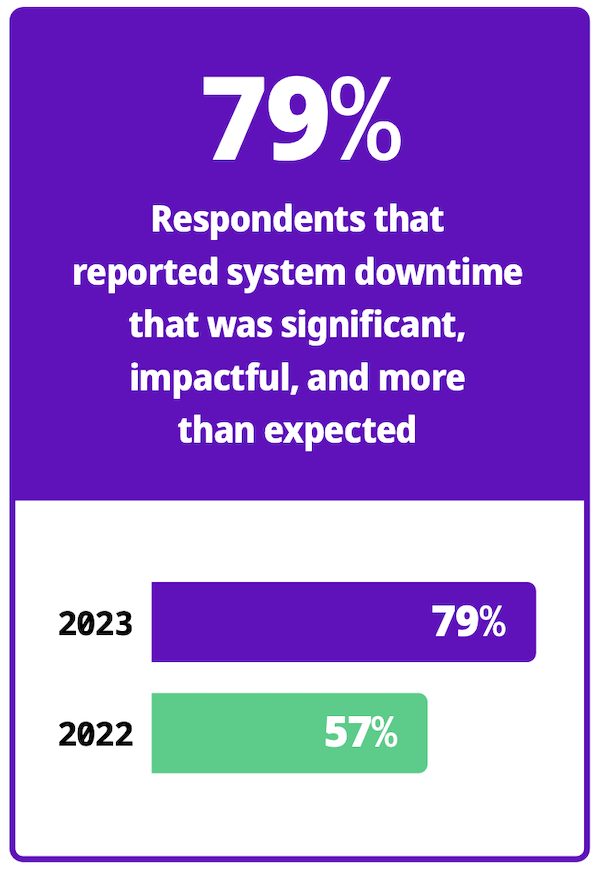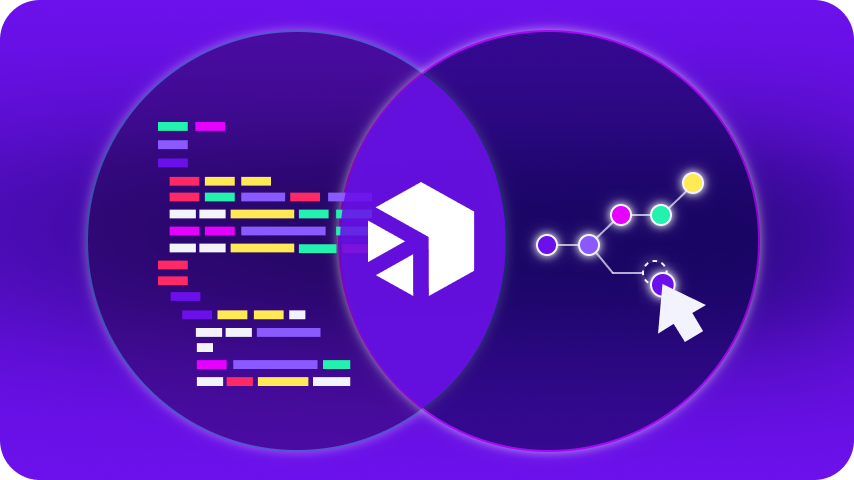October 12, 2022
As a business leader, you’re responsible for the health and success of the company. Accountable to the board, investors, customers, and employees, you must ensure the organization responds with agility to changes in the market.


In the recent Digibee Enterprise Integration Report [1], one of the data points we uncovered was particularly surprising.
When asked about downtime encountered during their integration project, 79% reported system downtime that was significant, impactful, and more than expected. This is a 27% increase over 2022 [1].
Based on the survey results and interactions with our customers, it’s clear the majority of enterprises embarking on an integration project simply presume downtime will occur (and likely a lot of it). Rather than the exception, downtime has become the rule with many technology leaders factoring it into their integration strategies.
But it doesn’t have to be like this.
Downtime: Costs to the Business
We all pay a price for downtime and it’s only going up. In 2014, Gartner research indicated that the average cost of downtime was $5,600 per minute, for an hourly average of over $300K.
$1 Million/Hour
Cost of downtime per hour
In 2022, ITIC research shows the cost has increased significantly for 90% of SME and large enterprises, with 44% reporting that a single hour of downtime could potentially cost over $1M. A staggering hit to the bottom line.
While security is at the top of the ITIC research list in terms of issues impacting downtime, integration/interoperability ranks in the top ten, along with human error, software bugs/flaws, complexity in configuring new apps, and understaffed/overworked IT departments. All of these are likely enterprise integration challenges you may encounter during your project.
The Big Bang Strategy
Typically, the blame for downtime is attributed to the integration technology. However, based on our experience, this outcome is more often due to poor planning or a lack of planning overall. While the integration strategy you create is critical to the strength of your plan and its execution, the wrong strategy will only compound the downtime your business encounters.
We see this a lot with big bang enterprise integration strategies. This model requires that you integrate all business modules at once. On paper this seems like an efficient and faster method to achieve enterprise integration, but in real-life it is extremely time-consuming and inefficient.
With a big bang strategy, critical failures increase since testing occurs at the end of the project once all integrations are complete—versus incrementally throughout the project. Tracing individual failures is also more complicated and time-consuming, forcing developers to go back and test each integration point. Similar to a string of holiday lights, when one bulb fails, they all fail. The system can’t be restored until the fault is located.
The Enterprise Integration Platform as a Service Strategy
Of course, a zero downtime deployment is rarely possible as we all encounter some integration problems during these projects. But with an effective integration strategy and the right technology, the risk of downtime and interruptions to the business are minimized.
Unlike big bang strategies that force us to rework the majority of existing integrations due to downstream dependencies, iPaaS technology enables a more deliberate, phased approach. Instead of investing significant manpower and resources out of the gate, iPaaS delivers a thoughtful and linear model that expedites outcomes while saving time and money.
Three Steps to Minimize Business Downtime
“Are you building around the tool or is the tool building around your business?”
Based on our work with enterprises across industries, here are three constructive steps that will help minimize business downtime during your integration project:
1. Select the right technology
Select a solution that allows you to build enterprise integrations the way you want them to be built. Ask yourself: are you building around the tool or is the tool building around your business? The technology you select must meet you where you’re at today, not the other way around. Adjusting your business model to accommodate your integration platform will almost always lead to unnecessary downtime.
2. Focus on the subset of connections
Abstract out the different connections across your entire integration strategy, then focus on the essential piece you want to migrate. Maintain all other systems, allowing them to coexist as usual by decoupling architecture from data flows. Contemporary iPaaS technology allows you to apply this metered approach for greater flexibility and uptime.
3. Minimize rework
Rework and downtime are inextricably linked. But while some rework is required for your integration project, it’s certainly not at the scale of a big bang strategy where all existing integrations must be touched. An iPaaS solution allows you to integrate in stages versus all at once. Smaller teams are able to perform the work at a faster cadence for an agile and cost-effective project.
The Digibee iPaaS provides additional measures to help our customers avoid downtime and other enterprise integration issues.
For example, the platform runs legacy and modern systems in tandem during implementation for always-on reliability. While your company carries on business as usual, system architects and developers are building, running, monitoring, and securing your new integration infrastructure. The formal switch-over doesn’t occur until all connections are tested and validated. Best of all, this model is repeatable, carried out each time a new integration is enabled.
Your Enterprise Integration Business Case
You already face an uphill battle quantifying the value of an intangible such as enterprise integration to secure funding and support for the project. Diminishing promised value due to business downtime and other avoidable outcomes only weakens your position.
If you are in the midst of planning an integration strategy for your organization, you’re not alone. Read the Digibee Enterprise Integration Report to learn how 1,000+ of your peers are preparing for their digital transformation. The report examines common pitfalls, best practices, and key takeaways to help inform your business case.
[1] This blog post, originally published in October 2022, was updated to reflect data from the 2023 State of Enterprise Integration Report published in April, 2023.













